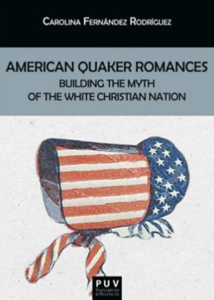Books and Special Issues

Paloma Fresno-Calleja and Hsu-Ming Teo (eds): Travel and Colonialism in 21st Century Romantic Historical Fiction. Exotic Journeys, Reparative Histories?. London: Routledge, 2025.
Romantic fiction has often involved stories of travel. In narratives of the journey towards love, “romance” often involves encounters with “exotic” places and peoples. When history is invoked in such stories, the past itself is exoticised and treated as “other” to the present to serve the purposes of romanticisation: a narrative strategy by which all manner of things – settings, characters, costumes, customs, consumables – are made to perform a luxuriant otherness that amplifies the experience of love. This volume questions the reparative function of Anglophone romantic historical fiction to ask: can plots of travel and discourses of tourism empower women while narrating stories of healing for the wounds of the past? This is the first volume to consider how romanticised and exoticised women’s historical fiction not only serves the purposes of armchair travel, but may also replicate colonial discourse, unintentionally positioning readers as neocolonial, neo-Orientalist cultural voyeurs as well as voyagers.

Hsu-Ming Teo and Paloma Fresno-Calleja (eds): Conflict and Colonialism in 21st Century Romantic Historical Fiction. Repairing the Past, Repurposing History. London: Routledge, 2024.
This book explores how postmillennial Anglophone women writers use romantic narrativisations of history to explore, revise, repurpose, and challenge the past in their novels, exposing the extent to which past societies were damaging to women by instead imagining alternative histories. The novelists discussed employ the generic conventions of romance to narrate their understanding of historical and contemporary injustice, and to reflect upon women’s achievements and the price they paid for autonomy and a life of public purpose. The volume seeks, firstly, to discuss the work of revision or reparation being performed by romantic historical fiction and, secondly, to analyse how the past is being repurposed for use in the present. It contends that the discourses and genre of romance work to provide a reparative reading of the past, but there are limitations and entrenched problems in such readings.

‘Australia from the Heart’: Envisioning Affective, Environmental, and Material Reparations. The Journal of European Association for Studies of Australia 14.1 (2023)
This special issue of JEASA derives from the EASA Conference held at the University of the Balearic Islands in 2023. The conference’s main objective was to explore the multiple affective and material dimensions associated with the notion of reparation, and associated concepts of restitution, redress and reconciliation.The articles gathered in this special issue derive from the many insightful and lively discussions held during the conference and collectively grapple with the many faces of this reparative process, one which—borrowing from the Uluru Statement—must come “from the heart.”

New Romantic Narratives for the 21st Century. Esferas Literarias (number 6, 2023)
This monographic issue of Esferas Literarias (published by the University of Cordoba) explores romantic narratives produced in the twenty-first century in light of their ongoing expansion, diversification and commercial success. In the context of this monograph, “romantic narratives” is used as a flexible term applicable to popular romance novels, films, and other media narratives which revolve around one of more central love stories and articulate what Catherine Roach calls in Happily Ever After (2016) the “romance story”. The issue includes articles by Cristina Cruz Gutiérrez, María García Muñoz, Jayashree Kamblé, Nattie Golubov and Francesca Pierini.
PREVIOUSLY PUBLISHED:

Fernández-Rodríguez, Carolina 2021: American Quaker Romances. Building the Myth of the White Christian Nation. Biblioteca Javier Coy de Estudios Norteamericanos. Valencia: Publicaciones de la Universidad de Valencia.
Quaker characters have peopled many an American literary work—most notably Uncle Tom’s Cabin—as Quakerism has been historically associated with progressive attitudes and the advancement of social justice. With the rise in recent years of the Christian romance market, dominated by American Evangelical companies, there has been a renewed interest in fictional Quakers. In the historical Quaker romances analyzed in this book, Quaker heroines often devote time to spiritual considerations, advocate the sanctity of marriage and promote traditional family values. However, their concern with social justice also leads them to engage in subversive behavior and to question the status quo, as illustrated by heroines who are active on the Underground Railroad or are seen organizing the Seneca Falls convention. Though relatively liberal in terms of gender, Quaker romances are considerably less progressive when it comes to race relations. Thus, they reflect America’s conflicted relationship with its history of race and gender abuse, and the country’s tendency to both resist and advocate social change. Ultimately, Quaker romances reinforce the myth of America as a White and Christian nation, here embodied by the Quaker heroine, the all-powerful savior who rescues Native Americans, African Americans and Jews while conquering the hero’s heart

Pérez- Fernández, Irene and Pérez-Ríu, Carmen eds 2021: Romantic Escapes: Post-Millennial Trends in Contemporary Popular Romance Fiction. Bern: Peter Lang.
Romance continues to stand as the most profitable literary genre and the second most read book category. The developments reshaping the conventions and marketing practices of popular fiction, both inside and beyond the books themselves, have affected the romance genre in specific ways that demand critical attention. This book brings together a collection of twelve chapters on postmillennial developments in contemporary popular romance fiction produced in different countries in order to prove how the genre, which has always been sensitive to customer demands and market trends, has continued to evolve accordingly. The chapters focus on how traditional formulae are being reshaped and adapted to meet readers’ expectations and market demands within this thriving transnational industry.
